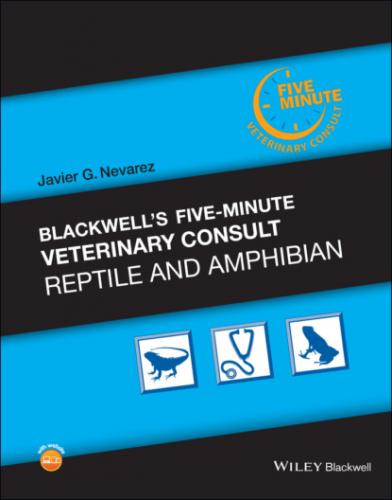Significant weight gain that does not match the growth of the animal may also be identified.
These changes could be due to the pathologic effects of the retained follicles, an underlying disease, or both.
In most cases, this is a chronic disease and the owners are not aware of the fact that their chelonian is in follicular stasis.
Other abnormalities identified in physical exam may include dehydration, poor body condition score, and pliable shell.
RISK FACTORS
Husbandry
Inappropriate husbandry is likely a significant contributing factor to the occurrence of follicular stasis.
Beyond temperature and humidity, inadequate UVB light exposure and calcium supplementation is key in the development of NSHP, which in turn can have a significant impact in calcium availability and follicular development.
Many chelonians presenting for follicular stasis also have concurrent NSHP.
An often‐forgotten aspect of the husbandry of reproductive female reptiles is the provision of an adequate substrate for nesting/oviposition.
It is often accepted that reptiles that may not perceive the environmental conditions are adequate for successful reproduction will resorb the follicles through atresia.
In captivity, there may be a combination of factors that do not allow for normal follicular atresia.
Others
A less discussed topic is the effect that lack of exposure to males may have on the reproductive cycle of reptiles.
Many reptiles display courtship and breeding behaviors that likely influence the proper hormonal stimulation of prospective females.
Many female chelonians in captivity are kept alone without the benefit of behavioral cues from a male counterpart.
This possibility of a behavioral effect must be considered, especially when animals are maintained in proper husbandry and are otherwise healthy.
DIFFERENTIAL DIAGNOSIS
Dystocia
Neoplasia
Egg yolk coelomitis
Ovarian cysts
GI obstruction
Constipation
DIAGNOSTICS
Imaging
Radiography: follicles appear as non‐calcified, round to ovoid, variably sized soft‐tissue opacities in the mid to caudal coelom. At times, the follicles may either be large enough, or in large enough numbers, to encompass over 50% of the coelomic cavity.
Ultrasound: early follicles appear as anechoic and progress to have more echogenicity as they mature or fail to ovulate. Follicles with a more heterogeneous distribution within the lumen should be highly suspicious of being retained follicles as the material within becomes firmer and inspissated. Ultrasound examination and aspiration of any free fluid can also be used to rule out egg yolk coelomitis.
CT scan and MRI: both these modalities are extremely sensitive at identifying follicles and can better assess the differences in size, shape and content of the follicles.
Coelioscopy: coelioscopic examination allows for confirmation of the presence of follicles and evaluation of their color and size to help make a determination of whether the presentation may be pathologic.
Hematology and Biochemistry
Chemistry panel: a chemistry panel is essential to help identify other possible underlying disease processes such as dehydration and NSHP. In addition to Ca and P, Mg levels should be documented as it also plays an important role in Ca homeostasis. Levels of Mg below 1 mg/dl and/or ionized Ca below 1 mmol/l should be considered deficient. Hypercalcemia and hyperphosphatemia are common findings in reproductively active female chelonians.
CBC: a leukocytosis indicates a significant inflammatory response that may suggest an additional underlying disease like egg yolk coelomitis.
PATHOLOGICAL FINDINGS
Grossly, follicular stasis can be differentiated from dystocia by the presence of follicles outside of the oviduct.
At times, the follicles may be large enough to appear to be in chains but are surrounded by the ovarian membrane rather than the oviduct.
Healthy follicles should be smooth and white to yellow in color.
A deviation from this appearance (i.e., dark, shriveled, or cystic follicles) is indicative of pathology.
Hepatic lipidosis may also be a common finding due to the chronicity of these cases.
APPROPRIATE HEALTH CARE
The treatment approach to follicular stasis is based on diagnosis and treatment of contributing factors leading to the stasis and treatment of the stasis itself.
The species of chelonian, clinical condition at presentation, amount and appearance of the follicles based on imaging or coelioscopy, and ability to provide a suitable environment all contribute to the decision‐making process.
All chelonians will benefit from medical treatment even if surgery is ultimately required.
Medical therapy consists of correcting the husbandry, providing an appropriate nesting area, and supportive therapy with emphasis on correcting calcium deficiencies.
If the chelonian appears to be stable, medical therapy alone can be attempted and the animal monitored for evidence of follicular atresia.
There are no timelines as to how quickly atresia can be expected.
The use of proligestone has been reported to have unreliable results.
Ultimately, many if not most cases require surgical intervention.
NUTRITIONAL SUPPORT
Dietary deficiencies must be corrected with special emphasis on UVB light and oral Ca supplementation.
Supplemental feeding should also be considered, since many of these animals may have hepatic lipidosis.
CLIENT EDUCATION/HUSBANDRY RECOMMENDATIONS
Clients should be encouraged to seek veterinary care of chelonians early on to establish individual baseline values and confirm the sex of the animal.
Follicular stasis likely has a multifactorial cause, so all husbandry deficiencies must be corrected with emphasis on UVB light, calcium supplementation, nutrition, temperature, humidity, and provision of adequate nesting substrate for oviparous species.
Chelonians should be weighed at least weekly to document any sudden weight increases that may
